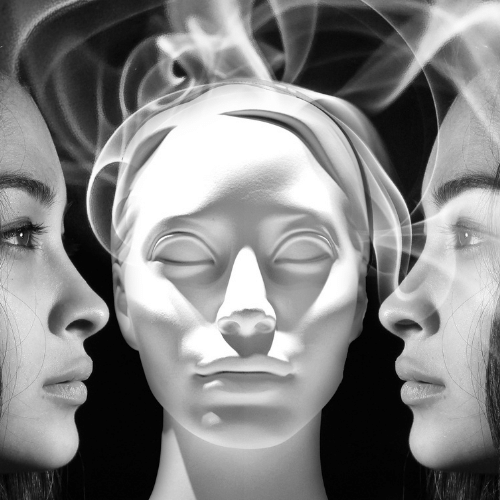Table of Contents
How Personality Forms Positivity Versus Ennegram (3 Philosophies)
Personality..Understanding the Process of Personality Development and the Enneagram to gain insight into who you really are
First things first: we’re going to try to answer the fundamental query of the day: what exactly is personality, and where does it come from?
These days, prospective employers often inquire about applicants’ personal lives. Online test taken by the general public. observed by scientists and predicted by astrologers.

The process through which our identities are shaped by our upbringings is fundamental to our grasp of ourselves. Therefore, it is an important area of study in psychology.
The Psychoanalytic View
Psychoanalytic theory, founded by Sigmund Freud, the founder of psychoanalysis, holds that an individual’s personality is a reflection of the subconsciousness. In Freud’s view, there were three unique parts to a person’s personality.
Id
A person’s core instincts, desires, and temperament fall under their purview. It’s based solely in the subconscious.
When the Id wants something, the self (or ego) steps in to apply its own value judgment and help the Id get it. It exists in the subliminal as well as the overt mental realms.
Superego
Division in charge of implementing moral standards and dealing with feelings of shame and guilt. It pervades both the awake and the sleeping brain.
The humanistic theory was conceived by Abraham Maslow in the 1950s. The focus on pathological individuals in psychoanalytic theory, in his opinion, was fundamentally faulty.
Humanist theory
Alternatively, Maslow emphasized familiarity with a person’s baseline level of consciousness and character. Humanistic theory asserts that individuals make decisions driven by a deep-seated need to improve themselves.
Individuals’ interactions with their surroundings and their interpretation of those interactions form the foundations of their personalities.

Maslow’s well-known “hierarchy of wants” concept emerged from the humanistic theory of personality and proposes that as people’s basic needs are met, they are replaced by more sophisticated ones.
The five stages of need are described in Simply Psychology. From most impressive to least impressive, below are the rankings:
- Self-actualization requirements
- Explicit needs for admiration and social approval
- Social and emotional requirements
- Issues of security
- Biological necessities
The Trait Theory
Gordon Willard Allport provided a broad definition of trait theory, which states that an individual’s personality consists of a set of stable features. You can classify people into three broad categories based on their distinguishing features:
-Cardinal Characteristics
A person’s core characteristics can be summed up in five to ten words. These could consist of traits like shyness or cleverness.
-Secondary Characteristics
All of them are situational. A person’s aversion to particular flavors or hues could serve as an illustration.
A Social-Cognitive Perspective:
The social premise of Albert Bandura’s social cognitive theory is that individuals’ identities are shaped by their relationships with others. Williams and Cervone state two precepts that form the basis of their theory:
– Individuals’ internal mental states, social context, and outward actions all have mutual effects on one another.
– People can be viewed in terms of their capacities to form cognitive representations of experiences, to reflect on and improve those representations, and to learn new things.

In terms of social cognitive theory, personality is learned through observation. As a result, if the adopted behaviors are reinforced, adaptation and forced integration occur. The focus of social cognitive theory is to unite the two extremes of the personality spectrum, those that place an emphasis on conduct and those that place an emphasis on cognition.
Kim explains how these four theories are used in practice within the area of psychology.
• Psychoanalytic theory recommends a more in-depth and “past-focused” method of care for patients. For better care, counselors may sometimes examine clients’ backstories.
• Humanistic theory advocates for a present-minded approach to client issues.
• Trait theory is helpful in the scientific investigation of personal character (as opposed to therapeutic services). Scientists can use it to make sense of the relationships between traits, emotions, and actions.
• The field of social psychology is enriched by the contributions to our understanding made possible by social cognitive theory. This enables them to investigate how varying environmental factors might prompt varying behavioral responses in individuals.
Personality is elusive and difficult to pin down. Since Sigmund Freud first discussed the ego and the id in an attempt to describe the complicated collection of factors that make you, you, there has been an endless flood of hypotheses.
The formation of the psychodynamic approach is a mystery, as is what exactly defines it. What occurs to you along the road from helpless embryo to complicated adult human self that makes you a distinct individual unlike anybody else on Earth?
- Is it genetic?
- Is this how your parents brought you up?
- Is it because of your surroundings?

All of them is the obvious solution. Even if we could prove that we are not merely Pavlovian-conditioned mammals, we would still have no idea whether or not we are free to choose our own identities.
Unfortunately, you’ll need to take a stance on the issue anyhow, as there isn’t universal agreement.
And we went with this one:
The German psychologist Stefanie Stahl, in her finest book, “The Child in You,” outlines the process of becoming an individual by identifying stories as the primary means by which we construct our sense of place in the world.
A person’s genes do play a role in how that person processes information and how that person responds to a given set of circumstances. The experiences we have, especially those we have in our formative years, have a far greater impact on who we become as adults.
The experiences we’ve had leave an imprint on who we are now and forever. In retrospect, it appears that the young you who went through those things is still a part of you.
Stahl distinguishes between the “sun child,” the part of us that has positive recollections and a sense of being adored, endorsed, recognized, and self-assured; and the “shadow child,” the part of us that was traumatized, that was told in some way that it wasn’t okay to represent the way it was or that it did not possess what it required to exist in this world.
According to Stahl, these harmful signals are at the root of pretty much every issue we encounter as adults (apart from things we can’t do anything about, like death, disease, and natural disasters). Our childhood selves still have them.

Typical examples of such communications include:
“I’m dumb.”
“I am helpless.”
“I weigh too much.”
“I’m too skinny.”
It’s true; I’m a complete failure.
“I am to blame for your mood.”
“I am little.”
“I have to live up to your standards.”
“This world is perilous.”
Even if I try, I know I’ll come up short.
“I am unwanted.”
Alternatively, I feel that there isn’t enough for me and I don’t fit in.
Our defenses against such signals strengthen with age, making them less devastating. We use them automatically whenever the situation calls for it.
If I’d been a grownup on that spring day, I could have assured my younger self that everything would turn out well, but alas, I wasn’t.
I could’ve reassured him that I wouldn’t go hungry, that kids can be harsh, but that I was still permitted to appreciate the day. To the contrary, I might have urged myself to use the chance to practice paying closer attention during classroom announcements.
Additionally, if I had a different personality, I might have concluded that I needed to struggle for survival or that I needed to rely on people more.
But whatever ending I get, and whatever ending you get, it stays with you. My ex-girlfriend at the time finally confronted me about my bad manners at buffets after years of this behavior.
She had seen how I rushed to the front of the line with a fanatical devotion, as if my life depended on it. For the first time, I gave it serious consideration, and I realized that a part of me is absolutely certain that nothing will be left for me if I don’t get in first.
The latecomers won’t be treated to ice cream (?)
Logic tells us that this cannot be the case. If there’s a buffet nearby, I won’t be leaving hungry. In fact, I often overeat to the point of feeling unwell. Despite this, I was always the first one to charge to the front.
The convictions of my childhood self-overpowered my more mature reasoning.
So now we’ve arrived at the core of the issue.
Humans’ primary drive is to stay alive. Our bodies and brains are hardwired from birth to detect danger and devise strategies to overcome it.
Our immune system does that work for us internally. We must do something else, though, for our mental health.
Because of the pain we had to endure as kids because our needs weren’t satisfied, we developed a shield to protect ourselves from future hurt. Our self-conceptualizations and worldviews provide the material for this shield.
As children, we rely on this shield unknowingly to protect us from the challenges of interacting with adults, conforming to societal norms, and meeting our basic requirements.
After all, it was useful. Although our methods were initially haphazard and experimental, we quickly found out which ones worked best for us and abandoned the rest for cost savings.
Over time, we stopped noticing that we were protected by this shield. We began to see ourselves in it. Instinctively, we began to identify with the character.
“I’ve always been this way.” We failed to account for the presence of another person below. We’ve forgotten that our version of events is simply one of many possible ones because we’ve become so invested in our own narrative about the world.

The world’s complexity worked to our benefit, as it provided us with ample opportunities to corroborate our worldview every day. Until we were hopelessly trapped inside it.
We would live in a perfect world where we could adopt any point of view and pick and choose among the many possible responses to any given circumstance.
But our personalities are so conditioned that we keep using the same method, and eventually it becomes intrinsic to who we are. The strategy has several inherent problems, as do all such unilateral ones.
It’s a well-known adage that when your only tool is a hammer, any difficulty starts to appear like a nail.
The same holds true for who we are as people. Once we’ve internalized a particular worldview, we tend to use it in every situation, even if we only obtain worse outcomes.
When you look at it that way, your identity stops being a cool suit of armor and starts looking more like a stifling prison.
A prison from which we have voluntarily been barred.
To sum up, our core set of beliefs about who we are and how our world functions form the foundation of our personalities, which we form in early life.
These convictions determine how we act on a daily basis, how we interact with others, and how we view the world at large.
This brings us to the article’s final query. What sense does it make to argue about a finite number of character traits since each individual has their own specific history and worldview?
In particular, the Enneagram identifies only nine distinct personality types.
The Enneagram, like numerous other theories of personality, was developed from the observations of therapists, psychiatrists, and advisors who observed that the narratives we tell ourselves can be distilled into nine main storylines.
These plot lines are so pervasive in human characteristics and human history that everyone can recognize at least one of them. What are widely known as the nine Enneagram personality types can be broken down into these nine narratives.
These nine tales could be summarized in one (of many) ways:

1 – I can only be a good person if I always choose the moral path. If you stray even a tiny bit, you will face severe consequences.
2 – I can only be loved if I prioritize the needs of others before my own. The pursuit of one’s own desires is a fundamentally selfish act.
3 – I can only be loved if I consistently outperform everyone else. Earnings are the measure of my value.
4 – I am odd, peculiar, and out of the ordinary. Not fitting in with the norm is the one thing that seems to set me apart as unique and unusual.
5 – the world is vast and overwhelming, and I am but a speck in it. To be successful, I need to keep a safe distance, watch, and learn as much as I can.
6 – I must exercise caution since the outside world is hazardous. A good outcome depends on my ability to maintain vigilance and readiness at all times.
7 – Life hurts, and I don’t know if I can keep going. That’s why I have to avoid discomfort at all costs.
8 – The world is harsh, and I am frail. In order to succeed, I must always give the impression that I am powerful, even when I am not.
9 – Being here doesn’t make much of a difference. I’ve learned that trying to draw attention to myself simply makes other people more irritated, so instead I’ll just play it safe and try not to stand out.
Every person on Earth may identify with some aspect of these nine narratives since they are universal. As you can see, though, they are still flexible enough to allow for slight variations in each account.
For example, Type Two’s story might make them think that their worth depends on how well they can put the needs of others ahead of their own. This story can be woven into many others to make the infinite tapestry that is the human mind.
In a way that no one else on Earth can, you are creating.
On the next episode, we’ll go into what it means to have a dominant personality type.

How Personality forms Positivity Vs. Enneagram (Part 2)
Every reliable method for categorizing people’s personalities must find a way to get past this one fundamental obstacle.
Watch the Youtube Video!: What exactly is Enneagram?
Read more on personality types: https://psytify.com/personality-types/
For more information: https://en.wikipedia.org/wiki/Enneagram_of_Personality
Social Media

